Textiles and lullabies – Ceyda Oskay’s residency in the art studio
Ceyda Oskay is the new artist in residence in our current exhibition, Room to Breathe. As with previous artists, we asked Ceyda and the curator in residence of the art studio, Dima Karout, a series of questions and answers to find out more about Ceyda’s artistic practice.
Ceyda uses textiles to explore symbolic themes around migration experiences, inviting us to engage with more abstract concepts and reminding us that individual migration projects are shaped by more than the structural dimensions of poverty or conflict. Her interest revolves around the exploration of dreams, utopias, dystopias in migration experiences, and her artistic practice features a unique use of textiles, imprints and interactive spaces.
Ceyda is also offering visitors the chance to participate in workshops where they can learn about, and contribute to the making of, a wide range of objects and artworks.
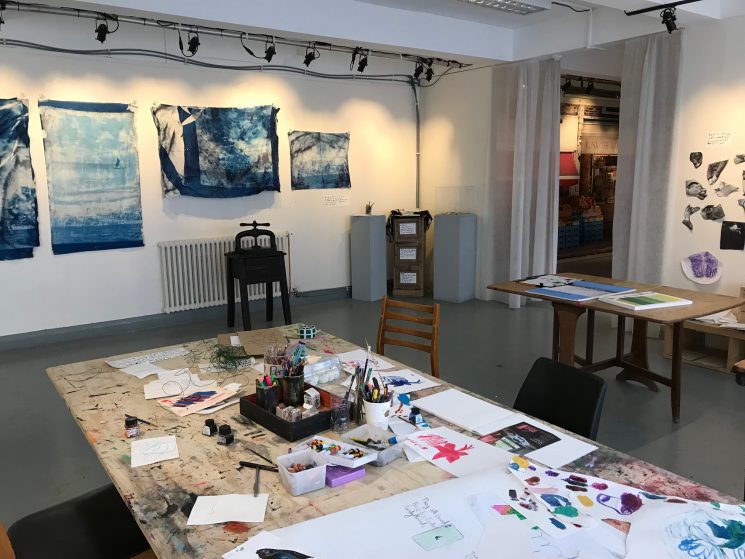
Ceyda Oskay’s studio in “Room to Breathe” © Migration Museum
Assunta Nicolini (AN): Textiles are the dominant medium in your artistic practice, especially your work currently on display at the Migration Museum – why textiles in particular?
Ceyda Oskay (CO): I’ve always been interested in textiles. My mother and grandmother taught me different textile techniques in Turkey and I remember making clothes for my Barbie dolls. Growing up in Saudi Arabia, part of the Silk Road, I remember going to fabric markets with my mother, where there would be textiles from all around the world. I loved textiles for their diversity and expressiveness. It always felt very natural for me to use textiles to express myself or my ideas with.
Additionally, socially, textiles have been very important in world history from the trade in natural dyes and the social status of Tyrian purple for royalty, the trade in indigo and its transformative effect on farms in India, to textile weaving and the British industrial revolution.
Having moved around a lot, I have always been interested in the versatility of textiles, and the way they can so easily be transported. I am also interested in, and I’m co-writing a chapter on, Sadu weaving – which is the nomadic weaving used to make tents and bags in the Arabian peninsula and beyond. There, the textiles form a home.
Additionally, textiles themselves are transformative – they can be changed into another item just by altering the way they are sewn and put together. They are easy to experiment with and I like experimentation in my work. I like the versatility and expression textiles offer, and their universality.
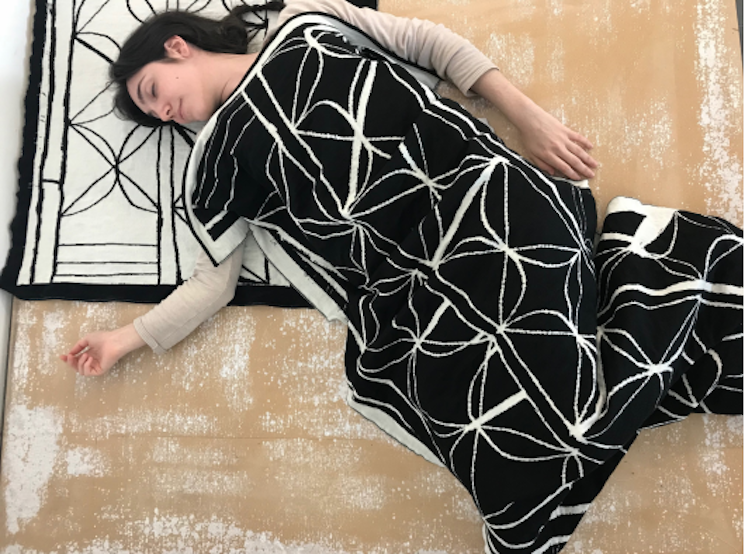
A doodle blanket, 2018 © Ceyda Oskay
AN: To what extent has your lived experience as a migrant and a practitioner working with migrants and refugees around the world shaped your artistic and conceptual work? And how did you develop your interest in ideas of utopia, dystopia and dream in migration contexts?
CO: Interesting question – because for many years as a practitioner, I couldn’t make art in the traditional sense. I started to move away from art as an object, or even installation, and towards art as an experience.
I was interested in migration and war as memory, having done humanitarian work in relation to Syria and Iraq – but, rather than preserving this memory in an object, I’m more interested in creating new and diverse experiences between people that transform them and create the hope of something better.
I’m really interested in the work of the Artist Placement Group (APG), which embeds artists in institutions – and in work like Francis Alÿs’s paint can, where he pours a thin line of paint along an international border.
In terms of dreams, I’m currently trying to make person-specific sleepwear and sleeping bags: the blue Cyanotypes were going to be transformed into sleep clothes, and I’m collecting images from friends that are of a place that inspires or calms them . . . I’m collecting sound recordings of lullabies in different languages, and trying to put that together with creating sleeping bags. It’s a way of bringing object, travel, experience and interactivity together. I’d love it if visitors contributed lullabies, or took part in the dream-clothes somehow.
AN: Dima, as curator in residence of the art studio inside Room to Breathe, could you tell us how and why you selected Ceyda’s work and how it relates to the other upcoming artists in residence?
Dima Karout: When I was invited to curate the art studio space, the first thing I proposed was to take a democratic approach and to launch an open call allowing us to reach migrant artists based in London and working on themes related to resilience through art.
We offered residencies to Ceyda Oskay, Shorsh Saleh and Belen L Yañez, three artists with a body of work inspired by their personal journey and human connections – artists who are generous, able to share their knowledge and creative process, and willing to include visitors in a participatory practice.
I was touched by Ceyda’s unique journey: travelling between countries, then landing in London with experiences related to different communities in which she had witnessed people’s stories and connection to their surroundings, and where she had created participatory art, and undertaken humanitarian work. I sensed that Ceyda’s presence at the Museum would provide visitors with an intimate experience and an elaborate understanding of the meaning of home and belonging.
When you step into Ceyda’s studio at the Migration Museum, you are immediately immersed in fragile stories assembled with a high level of sensitivity, intimate moments that she brilliantly re-created to communicate fragments of her journey. Ceyda created a dreamlike space for all of us to experience on our own: textile art filling the walls, a shell series presented in a corner, an open invitation to all visitors to share their lullabies, dreams and places. Through this experience visitors can engage in a wider conversation around the illusional borders that some of us have never visited and shake our perception about the meaning of a place.
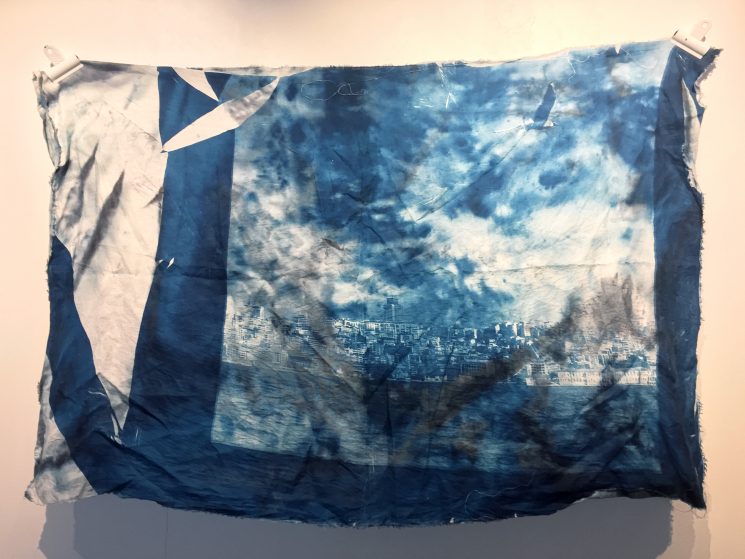
“The Bosphorous between Asia and Europe – The seagull has migrated from Peru – The textiles look dream-like, reminding us of dreams and places we go to in our dreams, and of utopias and dystopias” © Ceyda Oskay
A wall in Ceyda’s studio combines photos from the Bosphorus printed on fabrics using Cyanotype print technique. With its blue shades, the work brought the sky and the sea into my thoughts. And one of the photos in particular brought me to my own journey. I found myself glimpsing out of Ceyda’s window while juxtaposing my own hometown over her landscape – I floated to Damascus creating an assemblage of its building as if I were standing there in the comfort of my distant home.
Ceyda’s work is powerful. It took me and museum visitors on a textural and pictorial journey full of fragility, humanity, dreams and hope. And I am happy that with the museum team and visitors we were given the chance to discover and reflect on this influential work.
AN: Belen and Shorsh, as upcoming artists in residence, could you tell us how you relate to specific work by Ceyda?
Belen L Yañez: Ceyda’s piece “Hands on Subway/London Underground” instantly grabbed my attention. I am currently working on a piece called “Encounters”, in which I invite participants to establish a dialogue with each other using their hands to foster an empathic connection with people who may not share the same cultural background nor have the same physical appearance. Ceyda’s piece is composed of several copies of photos of the hands of immigrants and people travelling within London. Stopping for a minute and observing those hands is enough to allow you to read their meaning. It was wonderful to breathe the diversity of travellers who inhabit the London Underground, to imagine their stories and somehow to connect with them for a few minutes.
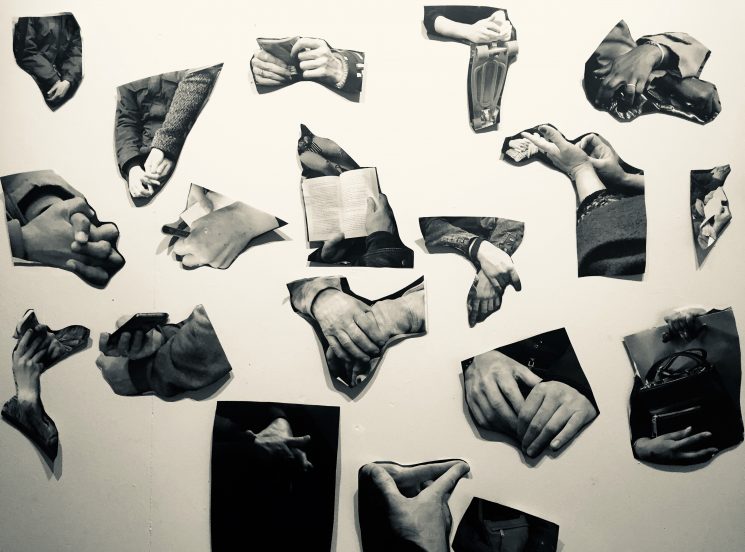
Hands on subway/London Underground of immigrants and people travelling within London © Ceyda Oskay
Shorsh Saleh: Ceyda printed oyster shells that she found on the Isle of Sheppey in the UK. The shells have images of military pillboxes falling over that look like homes; other shells have images of boats on them.
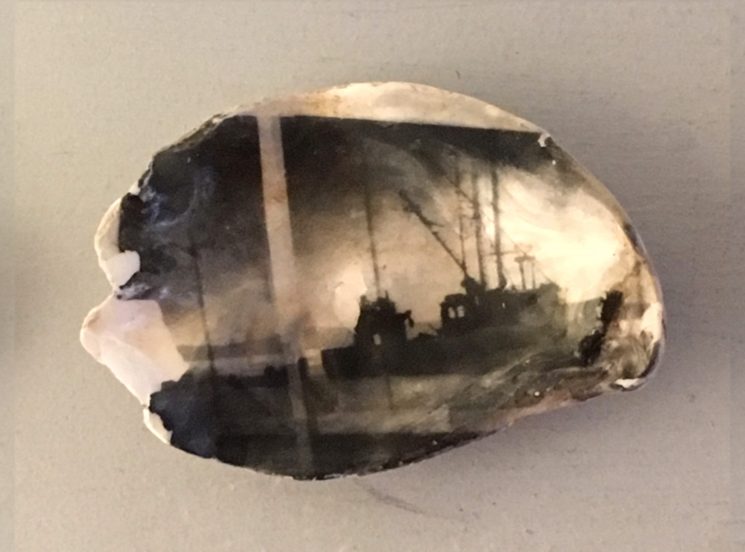
© Ceyda Oskay
As a migrant myself, Ceyda’s work spoke to me about journeys taken across seas in search of a new homeland. I felt a connection to the shell series she is presenting in her art studio. The ethereal imagery of boats and seascapes symbolises to me the difficulty of journeys, all contained within a broken shell that had once been a safe home.
Ceyda Oskay is in Room to Breathe until Sunday 31 March and will be holding a pillow-making workshop on Saturday 23 March and a family T-shirt making workshop on Saturday 30 March. Tickets for both these workshops are available through Eventbrite. Assunta Nicolini, gallery supervisor, is curating further blogs about the next artists who are due to have a residency in the gallery (details are available on our exhibition page).


Leave a Reply